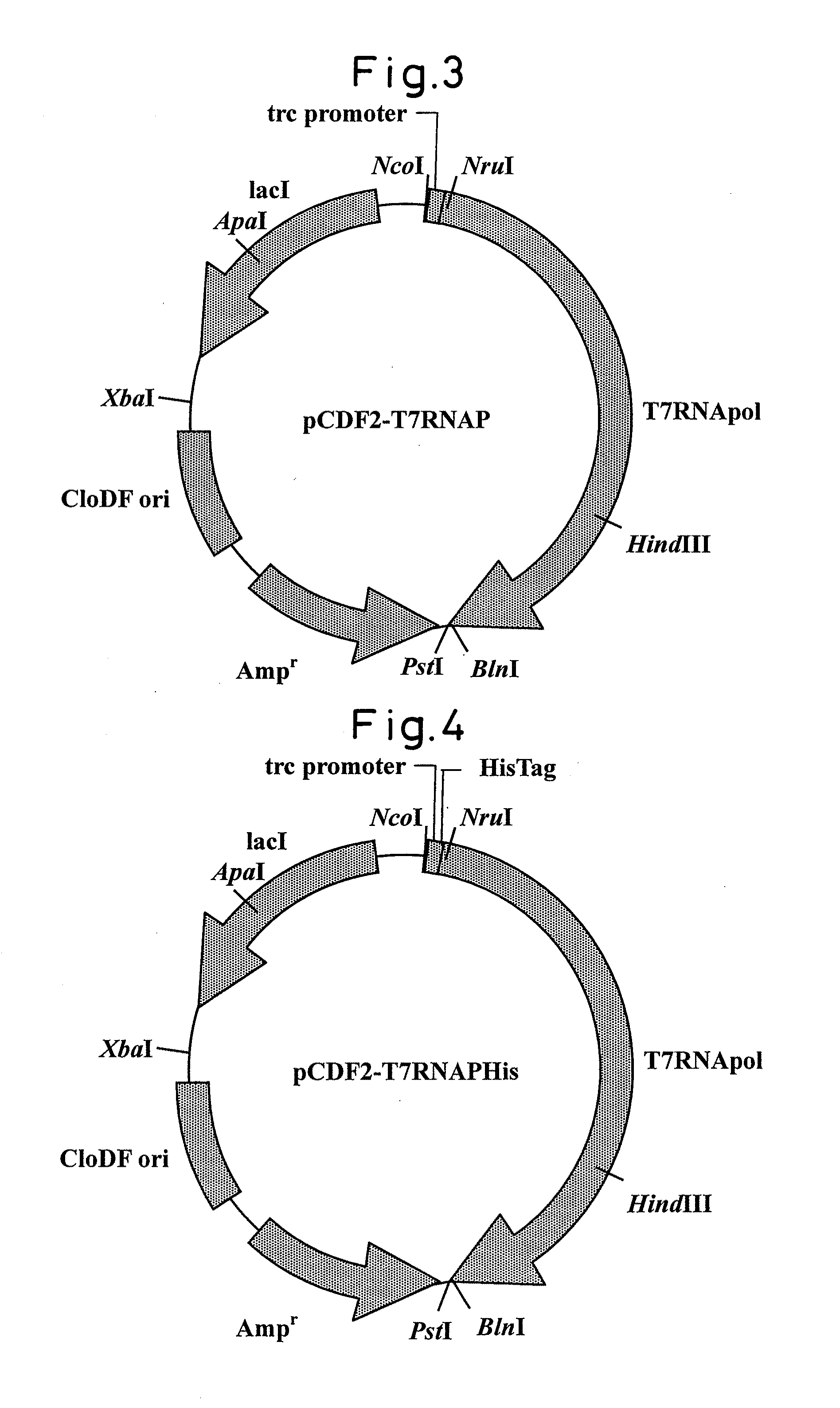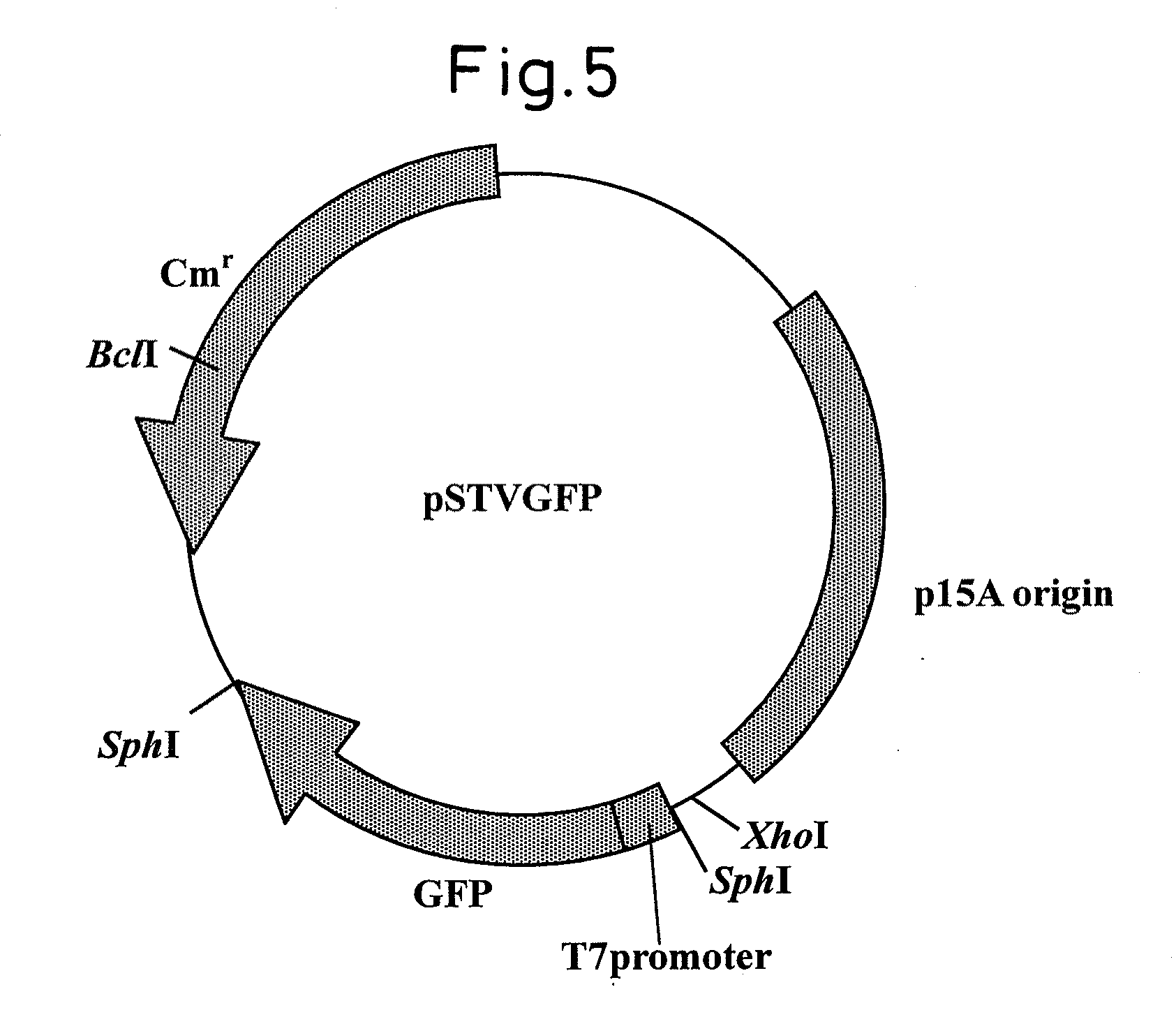RNA polymerase mutant with improved functions
a polymerase and function technology, applied in the field of rna polymerase with improved function, can solve the problems of difficult design of primers capable of highly sensitive detection in the trc method, the reduction of nucleic acid amplification efficiency is observed at 46° c, etc., to shorten the transcription reaction time and improve thermal stability and/or specific activity
- Summary
- Abstract
- Description
- Claims
- Application Information
AI Technical Summary
Benefits of technology
Problems solved by technology
Method used
Image
Examples
example 1
Cloning of T7 RNA Polymerase Gene
[0051]Cloning of T7 RNA polymerase gene was carried out according to the method described below.
(1) T7 RNA polymerase gene was amplified by PCR by dividing into a first half and a second half using a T7 phage genomic DNA genomic library (Sigma) as template plasmid with the following reagent composition and under the following conditions. Furthermore, among the synthetic DNA primers in the reagent composition, primer FF (SEQ ID NO: 1) and primer FR (SEQ ID NO: 2) were used for the first half of amplification, while primer RF (SEQ ID NO: 3) and primer RR (SEQ ID NO: 4) were used for the second half of amplification.
[0052](Reagent Composition) (total reaction solution volume: 100 μL)
Synthetic DNA primers200pM eachTemplate plasmid100ngdNTPs0.2mMTaq DNA polymerase (Takara Ex Taq0.025unit / μL(trade name), Takara Bio)Buffer provided for the enzyme
[0053](Reaction Conditions)
[0054]After initially heating for 2 minutes at 94° C., a temperature cycle consisting ...
example 2
Production of Expression Vector
[0055]A DNA fragment containing T7 RNA polymerase gene was amplified by PCR using the pTrC99A-T7RNApol (FIG. 1) produced in Example 1 as a template, and then ligated into pCDF2 plasmid (FIG. 2).
(1) A PCR reaction was carried out using pTrc99A-T7RNApol (FIG. 1) as a template plasmid with the following reagent composition and under the following reaction conditions.
[0056](Reagent Composition) (total reaction solution volume: 100 μL)
Primer pTrcF (SEQ ID NO: 7)200pMPrimer pTrcR (SEQ ID NO: 8)200pMTemplate plasmid100ngdNTPs0.2mMTaq DNA polymerase (Takara Ex Taq0.025unit / μL(trade name), Takara Bio)Buffer provided for the enzyme
[0057](Reaction Conditions)
[0058]After initially heating for 2 minutes at 94° C., a temperature cycle consisting of 1 minute at 94° C., 30 seconds at 58° C. and 2 minutes and 40 seconds at 72° C. was repeated 25 times using a thermal cycler (Perkin-Elmer).
(2) The PCR products were purified by subjecting them to 1% agarose gel electroph...
example 3
Production of Mutation Library (Part 1)
[0062]Mutations were introduced into T7 RNA polymerase gene of plasmid pCDF2-T7RNAPHis (FIG. 4) produced in Example 2 using the procedure described below.
(1) An error-prone PCR reaction was carried out by using plasmid pCDR2-T7RNAPHis (FIG. 4) as a template plasmid with the following reagent composition and under the following reaction conditions.
[0063](Reagent Composition) (total reaction solution volume: 100 μL)
MnCl20.1 to 0.3 mM(as necessary)Primer pTrcFs (SEQ ID NO: 15)200pMPrimer pTrcRs (SEQ ID NO: 16)200pMTemplate plasmid100ngdATP0.2mMdGTP0.2mMdCTP1mMdTTP1mMMgCl22mMTaq DNA polymerase (GoTaq0.01unit / μL(trade name) Promega)Mg-free buffer provided for the enzyme
[0064](Reaction Conditions)
[0065]After initially heating for 2 minutes at 94° C., a temperature cycle consisting of 30 seconds at 94° C., 1 minute at 55° C. and 8 minutes at 72° C. was repeated 25 times using a thermal cycler (Perkin-Elmer).
(2) The PCR product was purified by subjecti...
PUM
| Property | Measurement | Unit |
|---|---|---|
| Volume | aaaaa | aaaaa |
| Volume | aaaaa | aaaaa |
| Mass | aaaaa | aaaaa |
Abstract
Description
Claims
Application Information
 Login to View More
Login to View More - R&D
- Intellectual Property
- Life Sciences
- Materials
- Tech Scout
- Unparalleled Data Quality
- Higher Quality Content
- 60% Fewer Hallucinations
Browse by: Latest US Patents, China's latest patents, Technical Efficacy Thesaurus, Application Domain, Technology Topic, Popular Technical Reports.
© 2025 PatSnap. All rights reserved.Legal|Privacy policy|Modern Slavery Act Transparency Statement|Sitemap|About US| Contact US: help@patsnap.com



